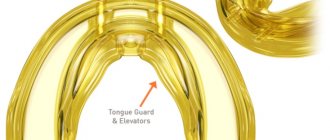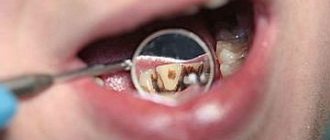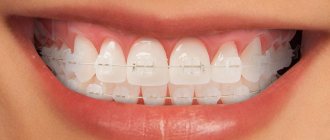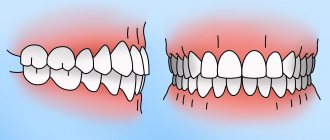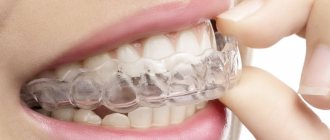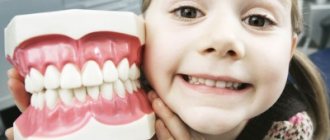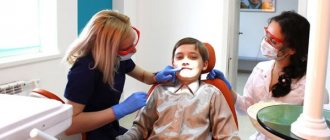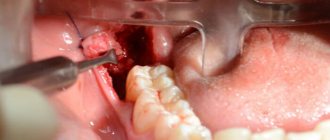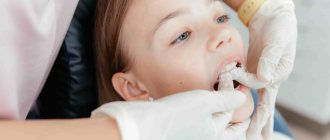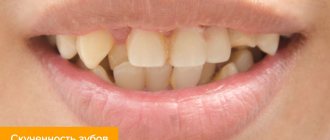Many orthodontists consider childhood to be the most appropriate age for correcting the position of teeth that have erupted and are just beginning to emerge, and for correcting malocclusion. This is due to the fact that the child’s jaw is still developing, so in a short time it is possible to correct existing defects and prevent the situation from getting worse. The most common reason for a child’s malocclusion is the lack of attention to this problem on the part of his mother. It is normal for a child to have a lower jaw that is smaller than the upper jaw, but during natural feeding this defect is usually corrected.
Many orthodontists consider childhood to be the most appropriate age for correcting the position of teeth that have erupted and are just beginning to emerge, and for correcting malocclusion.
The main causes of malocclusion:
- The hole in the nipple is too large (with artificial feeding). The child does not need to make any effort to obtain food and the jaw does not work or develop.
- Lack of roughage in the diet;
- Lack of minerals and vitamins in the body;
- Mouth breathing due to problems with blocked sinuses.
However, all this is not an insurmountable obstacle to getting a child a beautiful smile with straight teeth.
The most common reason for a child’s malocclusion is lack of attention from his mother.
Orthodontic equipment for teeth straightening and bite formation
There are several tools to straighten your teeth and form your bite:
- Trainers;
- Braces;
- Plates for teeth straightening.
Trainers
Most orthodontic devices designed to correct malocclusion eliminate the consequences of the pathological process, without excluding its cause. A dental trainer is a device that performs both tasks. Wearing trainers helps develop the jaw muscles, reduce pressure on the jaw bones, restore breathing through the nose and correct tongue position. Suitable for treating children from 5 years of age. They are especially effective when replacing baby teeth with permanent ones to correct their incorrect position. Wearing time is limited to night and a few hours during the day.
An impression is not required for production. Transparent silicone is used in different colors to make them more interesting for children to wear. Adapts well and does not affect diction. It is used for minor bite deviations, and can even replace braces if there are contraindications to wearing them.
First, trainers with soft silicone are used. Later, more stringent ones are used. Used for: deviations in tooth growth (location, direction, etc.), impaired swallowing function, pathologies of the oral cavity leading to chronic nasal congestion. They require daily care just like all devices.
Braces
Braces are special linings for each tooth, which are strung on a rigid metal arch. The main qualities of the arc:
- Strength;
- Elasticity;
- Availability of shape memory. No matter how the wire is bent during the treatment process, it tends to take its original shape.
Braces are the most common way to correct malocclusions. Starting from the age of 12 (the average period for the final eruption of permanent teeth), they can be installed in children. Braces are a non-removable device. They are attached to each tooth. Wearing them requires regular visits to your doctor, who determines and regulates the tension of the wire. When wearing braces, they are quite noticeable, and this affects the teenager’s behavior (they become more shy, tense and smile less often). The use of braces requires increased attention to oral hygiene (food gets stuck in the system) and imposes restrictions on the consumption of certain foods (hard and viscous). But despite the disadvantages, this is a very strong and durable design that allows you to eliminate many bite defects.
The use of braces requires increased attention to oral hygiene
Retainer
A retainer (in this case, a permanent retainer) is a thin wire made of the same material as the bracket arch. It is not an independent orthodontic device, but serves to prevent aligned teeth from returning to their original place. It is usually installed before removing braces, so we decided to mention it. It is not noticeable to others because it is attached to the inside of the jaw, where it is secured with dental cement that hardens under the influence of ultraviolet radiation. It is almost impossible to tear off, so there are no restrictions on eating hard and sticky foods.
Pros and cons of orthodontic structures
Let's look at the positive and negative qualities of the two methods of bite correction.
Pros and cons of permanent devices
They have their pros and cons as any method of bite correction.
Braces for children have the following advantages:
- provide rapid correction of anomalies due to continuous, powerful impact;
- corrects complex, congenital defects;
- wide range of application by age;
- easy adaptation;
- do not provoke problems with diction;
- quick repair possible;
- the ability to move dental units in the desired direction.
These devices not only have advantages, they also have disadvantages.
These include:
- low aesthetics of metal devices;
- difficulties in caring for them;
- high price.
Despite the inconvenience of correction systems and other disadvantages, it is widely used among adolescents.
Plates for teeth straightening
Orthodontic plates are often called “braces” or “plates on the teeth.” This device is used to treat children under 15 years of age. Made individually for each child. It is attached to the outer surface, the inner part and can partially cover the sky. Made from soft or medium hard plastic and metal. The child takes food without any discomfort. There is no need for any special care for the plates.
Purpose:
- abnormal development of the bones of the jaw arches (narrowness of the jaw bone or disruption of its shape);
- the need to adjust the position of one or more teeth;
- movement of individual teeth;
- the presence of gaps between teeth (three and diastemas);
- the need to correct the narrowing of the palate;
- activation or slowdown of the jaw growth process;
- consolidation of results after using other orthodontic systems;
- preventing crowding;
- prevention of relapses of malocclusion, etc.
There is no need for any special care of the plates
How to place a plate on a child’s teeth?
Installing plates on children's teeth usually takes several weeks, since they are made individually for each patient. To create a suitable orthodontic appliance, the patient undergoes an X-ray examination, then the doctor takes an impression of the teeth for the plate. After this, plaster models are made, from which the structures are created. Particular attention is paid to the exact match of the surface relief of the gums and the palate - the adjustment takes just over 10 minutes. After this, the child will be able to independently remove and put on the plate on the lower teeth and upper jaw.
Classification of plates for teeth straightening
According to use, the equipment is:
- removable;
- non-removable.
Removable
– the simplest design, and is installed on children from 7 to 15 years old for short-term correction of teeth or bite. Fixed with hooks and worn daily. The duration of wearing is determined by the attending physician. They are most often made of plastic, but sometimes they come in complex designs that include springs and screws. The doctor periodically adjusts the device to obtain gentle pressure on the teeth. This achieves a positive therapeutic effect. The teeth are straightened and the bite is corrected. Such equipment is used when it is not possible to correct the defect using only a plate. Can be installed on both the upper and lower jaw.
Fixed (stationary)
– installed once using fixing brackets that prevent movement when eating, for up to two years. Monitoring and adjustment is carried out by the attending physician during a scheduled visit. It is most often used for young children and to correct serious developmental defects of the jaw apparatus.
Differences:
- stationary is more effective in correcting defects. More expensive than the removable version;
- removable, easy to remove at any time. Easier to care for.
According to the material of manufacture:
- metal;
- plastic.
Metal
– made of titanium-nickel or titanium-molybdenum alloy, which do not oxidize in the aggressive environment of the oral cavity. Outwardly it looks like a combination of wires and hooks. It can be either removable or non-removable. Used to treat children of all ages.
Plastic
– most of these plates are removable and are intended for treating children of middle and older age groups.
By purpose and device:
- Single-jaw – used to restore the dentition when it is shortened or narrowed, as well as to eliminate defects of individual teeth. Consist of a plate with adjustable orthopedic screws. Suitable for children of all ages.
- With retraction arch. Correct protrusion of teeth in a row. Based on the elastic properties of the arc. Suitable for correction on both jaws.
- With a hand-shaped process on an arch. Correct the position of individual teeth. The process puts pressure on the tooth and aligns its position. Can be installed on both the upper and lower jaw.
- With active pusher. Used to straighten the maxillary anterior incisors. The dentition is aligned with spring mechanisms for each uneven tooth.
- The Andresen-Goipl apparatus (activator) is a removable orthodontic device of combined action designed to correct occlusal defects. The activator makes it possible to fix the lower jaw in the required (extended) position, which gives impetus to its development. In this regard, the growth of the upper jaw is inhibited, the bite is disconnected, and the work of the facial and masticatory muscles returns to normal. Placing the inclined plane of the plate along the entire dentition makes it possible to move teeth in three planes - to the side, back and forward. This allows, with some design changes and additions to the activator, to successfully use it to correct not only distal occlusion, but also other deviations of occlusion.
- Bruckle's appliance is a removable device designed to correct deep mesial bite. It is installed only on the lower jaw, and, due to its design features, it has a positive effect on both dentitions.
- Frenkel apparatus - lip pads, brush shields, and other additional elements are installed on a metal frame. The device is attached simultaneously to both jaws and has a functionally targeted action that limits unnecessary muscle force. The use of the device promotes the normal development of the jaws, dental arches and rows. Open, distal and mesial bites are corrected, but the complexity and duration of production, as well as the high cost, do not contribute to its popularity.
The procedure for adjusting and installing the plate is simple and painless. At first, the child feels discomfort from the presence of the equipment in the mouth, but then he gets used to it.
Differences in mechanism of action
Correction devices differ in their mechanism of action. Plate designs have one or more screws. They allow the growing jaw to expand, making room for permanent teeth. Metal arches correspond to the correct position of units in the dentition. The device cannot have a significant effect on the jaw. She cannot move dental units over a significant distance. It is used when there is no need to move it over long distances. It copes well with tilting and turning individual units. It is also used in young children to prevent malocclusion or to change the width of the growing palate.
Appliances for permanent wear have a wider range of possibilities for correcting malocclusion and dentition defects. The systems are able to place the tooth in the required place by pulling it out of the alveolus. Braces can immerse it deeper into the jaw, tilt it in the required direction, or rotate it relative to its axis. Unlike removable appliances, they are capable of correcting serious disorders of the dental system, and not just preventing them.
Procedure for making and installing plates for teeth straightening
The selection and production of plates for correcting the bite is carried out only after examination by an orthodontist. The technique is as follows:
- A volumetric image of the jaw bone tissue (OPTG) is taken;
- Impressions of the jaws are taken;
- They are sent to a dental laboratory to produce the selected plate;
After the orthodontic equipment has been manufactured, the doctor installs it and explains to the parents and child how to wear it. The fixed structure takes a little longer to install than the removable one. The procedure for adjusting and installing the plate is simple and painless. At first, the child feels discomfort from the presence of the equipment in the mouth, but then he gets used to it.
Indications and contraindications for installing braces
The appointment and selection of the correct design is recommended by the doctor.
Treatment is prescribed in the following cases:
- Incorrect position of one or more teeth;
- Jaw bone development problem;
- Narrowing of the palate;
- Malocclusion;
- Teeth displacement after braces;
- Rare arrangement of teeth.
Orthodontists recommend installing plates for children under 12 years of age.
Often plates are placed on braces after treatment to secure the result as a retainer. You shouldn't be afraid of this.
In this age:
- the body grows and corrections occur quickly;
- children at this age are not so painfully worried about the installation of plates;
- children are more obedient and will not remove the plates often.
Plates are not installed in the following cases:
- untreated caries;
- gum disease;
- allergy to plate material;
- respiratory tract diseases;
- presence of stomatitis that requires treatment;
- abnormalities have been identified that require other treatment methods.
Symptoms and causes of malocclusion
As a rule, malocclusion is not caused by one reason, it is usually a combination of several:
- Untimely eruption of baby teeth (to check this point, you need to see a dentist at the age of one year);
- Poor posture;
- Bad habits (excessive addiction to pacifiers, thumb sucking, toys, etc.);
- Breathing through the mouth rather than the nose (for example, with frequent colds);
- Heredity;
- Lack (or lack) of solid food.
Violations of the position of the teeth occur in 90% of cases, but only in 10-15% of them these violations are truly serious. Symptoms are visible to the naked eye:
- Teeth pushed forward or backward;
- Improper closing of the jaws;
- The teeth are rotated (around their axis);
- Excessive spaces between teeth;
- The dentition is not straight.
How long should you wear braces?
At the time of active formation of the dentition, the plates are changed approximately every six months. The duration of treatment is determined individually. Usually the defect is corrected in a year to a year and a half, further time is required to consolidate the result. Often plates are placed on braces after treatment to secure the result as a retainer. You shouldn't be afraid of this.
Caring for teeth straightening plates
In order for the equipment to work as expected, you need to perform simple operations. For this it is recommended:
- Clean the plate with a soft toothbrush;
- Use special cleaning gels (daily and weekly);
- Do not engage in active sports with the plate on;
- Store the equipment in a special container;
- Do not try to repair the plate yourself if you discover damage or deformation. You should consult your doctor;
- Treat the structure with a disinfectant solution. If the plate is removable, it is better to place it in the solution overnight;
- Remove the removable plates when eating;
- Before installation, rinse with warm boiled water;
- If the equipment design has a screw, it is recommended to lubricate it with vegetable oil so that it does not stagnate;
- Parents should ensure that the child does not remove the equipment at night;
- Teach your child how to tighten a screw in a plate;
- To avoid complications, periodically visit an orthodontist and follow his instructions;
- Carefully monitor oral hygiene during treatment (the presence of plates increases plaque in the mouth);
- If plaque or tartar is found on the plate, you should consult a doctor for cleaning.
The treatment is helped by a special massage that affects the gums and palate. By improving blood circulation, massage accelerates the healing and growth processes in the jaw area. This massage is performed while brushing your teeth.
What are plates and braces used for?
Plates and braces are used to correct a teenager’s bite. And also in order to make your teeth as straight as possible. Both plates and braces are popular dental treatment tools. Although they have huge differences. In terms of efficiency and price.
Differences in design between both types of medical instruments
The main purpose of braces and plates is to make a teenager’s teeth straight. But they achieve it in completely different ways. Both devices have different designs from each other.
Features of records
The plates are removable structures. Because they can be taken out of your mouth at any time. And then insert it back.
The advantage of the plates is that the teenager has the opportunity to remove them at any time. For example, when going to a birthday party. Or to some event at school. Also, the teenager will have to remove the plates at the moment when he washes himself. And also brush your teeth.
The plates are made primarily from a specialized type of plastic. However, some parts of the product can be created from different types of metal. In particular, we are talking about the temples. Special springs. And screws.
Features of braces
Braces are static devices. Taking them off and putting them on is impossible. They are installed by the dentist. And they are filmed by him.
Braces are only used if a teenager has serious dental problems. Severe illnesses or extremely noticeable pathologies.
Each bracket (unit of construction) attaches to one tooth. As strong as possible. So as not to fall off before the teenager completes the course of treatment for crooked teeth. That is, braces must last for at least 12 months. And don't fall off.
Wearing braces has a number of features:
- You will have to wear them around the clock. It will not be possible to remove them during the entire course of treatment. Under no circumstances.
- Braces are visible to people around the teenager. It attracts attention.
- You won't be able to remove braces yourself. The teenager will have to go to the dentist. And remove the structure from him.
Manufacturers use a variety of materials to create braces. Basically, they prefer ceramic products. Which are almost invisible when worn. Therefore, they are convenient for a teenager.
However, all braces have a special arch made of metal. Which negatively affects their appearance.
What is better - braces or braces?
The plates are only effective for people under 15 years of age and may not help in some situations. And even at the age of 10-12 years, in some cases it is necessary to install braces. If the pathologies are minor and are in the initial stage, then it is enough to use plates.
Advantages:
- Possibility to remove if necessary;
- Easy to care for your oral cavity;
- Cheaper than braces.
Flaws:
- Often not effective enough;
- Long-term addiction.
Advantages of braces:
- Continuous action on teeth;
- Quick addiction;
- A larger number of defects can be eliminated simultaneously.
Flaws:
- Difficulties in caring for the oral cavity;
- High cost for the entire range of services.
The cost of a dental plate in Moscow
The average cost of dental plates for children in Moscow varies from 8 to 15 thousand rubles. Do not forget that the design requires periodic correction and replacement, so visits to the doctor must be included in the total cost. You should also take into account other factors that affect the price, for example, the level of pediatric dentistry and the qualifications of specialists. In any case, you shouldn’t go after cheapness; the cost of dental plates for children should not be too low - the child’s health is more expensive.
Reviews of plates for teeth straightening
Looking through the reviews from parents, it can be noted that they are all positive. Children quickly get used to wearing the equipment. All dental defects are corrected quickly. It cannot be said that for all children the operation with the installation of plates is completely painless, but if everything is chosen correctly, the inconvenience quickly passes.
Dentists also respond well to the plates. Some believe that in adults, correcting defects with plates is even more convenient. For them, this is done even longer, once, but in children, as the jaw grows, the correction plates need to be changed.
Rules for the adaptation period
Before starting the course, the orthodontist must announce all the rules for getting used to and wearing the plate:
- You need to eat with the system on your teeth, since during this period the greatest load on the cutting edges is observed. At this moment, deformations and shifts occur most quickly.
- The structure is not removed at night. If these are double-jawed plates, then they are worn only in the evening and at night.
- The plate is cleaned twice a day - morning and evening. To do this, use a toothbrush and toothpaste. After eating, the structure can be removed and rinsed with warm water.
Summing up
Children's teeth are not only a cheerful smile. It is also an important link in the digestive tract. Depending on the quality of chewing food, the further process of digestion also depends. Disease of the teeth and gums often leads to inflammation of other organs. It is necessary to monitor the condition of a child’s teeth from a very early age. Replacing baby teeth with permanent ones should be natural. Often, an extracted baby tooth causes the molar to erupt in the wrong place, and as a result, the need for orthodontic treatment with plates or braces. Doctors say: “It is better to prevent a disease than to treat it.”
The appearance of malocclusion or crooked teeth must be corrected as early as possible. To identify abnormalities in a timely manner, it is recommended to bring your child for examination to the dentist at least twice a year, starting from the age of one.
Parents should ensure that their child learns to brush his teeth well as early as possible and help him do it correctly.
Periodically examine his oral cavity and if you notice a brown or white spot on his teeth, immediately contact a dentist. Currently, doctors have completely painless ways to treat caries.
Who should not wear trainers?
The systems described are primarily medical devices, so if you are impressed by the various photos before and after the trainer and want to buy such a device for yourself, be sure to consult with your doctor. Self-treatment with a trainer is dangerous and can cause harm.
There are other situations when it is better to choose another treatment option:
- if there is nasal congestion, which has become chronic (the patient simply will not be able to train at full strength, because he will have breathing problems);
- when the bite of the teeth in the lateral areas is cross;
- if a trainer is chosen for a child , but the child is uncontrollable and does not obey his parents (classes must be on schedule, otherwise there will be no effect).
In the described cases, it is better to use braces to correct a malocclusion.
Pros and cons of treatment with trainers
Why are dental trainers for adults and children so popular? This system has many advantages that make it popular and convenient. The main advantages of treatment using such structures:
- low price. The most budget trainer is very cheap, and modern improved models still cost 3-4 times less than an inexpensive brace system;
- ease of care. The patient does not require any special cleaning products or devices - just toothpaste and a brush are enough;
- versatility. The trainer does not need to be made specifically taking into account the patient’s characteristics; you just need to choose a model by size;
- wearing does not have a negative effect on the enamel or soft tissues, the devices do not injure the tongue or gums;
- In addition to bite, trainers also solve other problems, for example, correcting speech (in cases where diction problems were caused by incorrect dentition);
- the patient experiences minimal discomfort while wearing.
An additional advantage of trainer systems is that they do not cause any psychological discomfort: the trainer can be removed at any time to eat, drink or go to an important meeting. However, this method of changing the bite also has its disadvantages:
- slow effect. You need to wear the trainer for at least a year to see real results;
- prohibition on eating and drinking while wearing. If you take a trainer for a child , this can become a serious problem;
- Treatment must be carried out strictly according to schedule and for the required amount of time per day, otherwise there will be no effect. This option is only suitable for responsible people, and children should be supervised by parents.
Trainer effect: before and after
